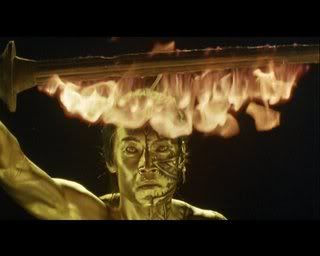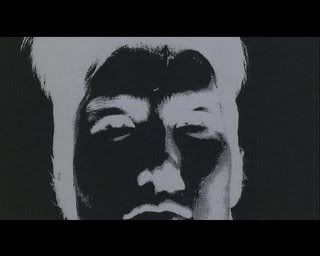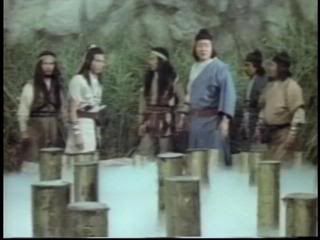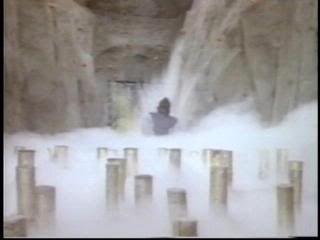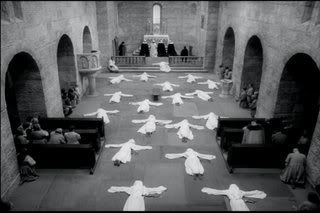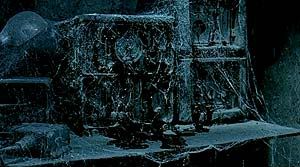
PLOT:
Ok. This might get messy. So, at heart it's a basic revenge movie in the vein of I Spit On Your Grave. A woman is raped by three thugs wearing make-up, and after getting out of hospital she tracks them down and kills them one by one. Meanwhile, an ex-lover/Interpol agent who abandoned her after the rape and remarried (awfully quickly) comes back into her life, and she also accepts the help of a bald, muscle-bound retarded guy. Oh, and she's involved in diamond smuggling in some way. OH! And we find out she has a twin sister who is also involved in the revenge scheme.
But, forget all of that. You might be wondering about the title: Ninja Champion. Where are the ninjas, goober? Well, there are ninjas here. We know they are ninjas because they dress up in bright red and blue pajamas, and sometimes have the word NINJA on their headbands. These scenes are actually entertaining in a silly way, but have absolutely no relationship to the revenge film outside of some dialogue that comically tries to tie things together. The film culminates in a DUAL TO THE DEATH between the white (good guy) and red (bad guy) ninja that apparently takes place on a playground. After some baffling exposition, red-guy gets stabbed on the monkey bars. Rough way to go.
But, forget all of that. You might be wondering about the title: Ninja Champion. Where are the ninjas, goober? Well, there are ninjas here. We know they are ninjas because they dress up in bright red and blue pajamas, and sometimes have the word NINJA on their headbands. These scenes are actually entertaining in a silly way, but have absolutely no relationship to the revenge film outside of some dialogue that comically tries to tie things together. The film culminates in a DUAL TO THE DEATH between the white (good guy) and red (bad guy) ninja that apparently takes place on a playground. After some baffling exposition, red-guy gets stabbed on the monkey bars. Rough way to go.

REVIEW:
Oh yeah. This is what bad is like. You may remember the name Godfrey Ho from my review of The Shaolin Drunk Monkey. In the mid-80s, our man Godfrey came up with a tremendous money-making idea. Ninjas were huge, so he purchased the rights to not-quite-complete films, sprinkled in some new scenes featuring rainbow colored masked ninjas, and then re-dubbed the whole thing and gave it a title like Rage Of Ninja, or Full Metal Ninja (Actual Titles!).
These low-budget titles were regular features in video stores in the 80s, and for anyone unlucky enough to see more than one a pattern soon began to develop. Ho would re-use footage constantly, commonly sticking his American actors in multiple films, though the footage was obviously all shot at once. It must have been his effort to corner the crucial Michael Dudikoff market.
For instance, the ninja star of this film (named.. Donald) is played by Bruce Baron. In 1986, Bruce Baron "starred" in The Ultimate Ninja, Ninja Destroyer and Challenge Of The Ninja. Take a wild guess who directed those three. It's a particularly creative form of hackery, and a ballsy one at that, since these films make almost no sense at all. On top of that, Ho takes full directing credit despite often not being involved with a majority of the footage actually on-screen! And that is how a director gets over 100(!!) directing credits in just under 30 years.
An even more egregious example is a minute long scene featuring Richard Harrison (who was a well regarded actor in Italy) who was in no less than 18(!!!) films with the word Ninja in the title. Almost all directed by Godfrey Ho, and almost always playing a character called Gordon since the footage for all of these films came from one session of filming.
But what about Ninja Champion? Obviously two separate films stuck together with chewing gum and spit, it's actually probably best to review them seperately.
The female revenge flick is bland, pedestrian stuff. In one scene the female protagonist is captured in a car and asks for a chance to put on make-up before her capturer (and former rapist) kills her. His response? "Don't do it too well, or I may want to rape you again before I kill you!". You stay classy, Godfrey Ho.
Oddly, there's actually a bit of kung-fu in the film, and it's not at all bad. My favorite bit is when the boyfriend/interpol agent jumps into the air and vanishes completely, leaving his attackers dumb-founded. If only he taught his lady-friend this teleportation trick!
But the film is limp and uninteresting. There's a bizarre early scene where Rose (our unfortunate female lead) visits a diamond smuggler and drops her top, revealing.. um.. shininess. Or a heavenly glow. Or something. It's quite bizarre, particularly since we get a gratuitous nipple shot about five minutes later.

Most of Rose's revenge attempts involve poison, so we're not treated to any I Spit On Your Grave penis-cuttings (Spoiler!), and it's frankly a little difficult to understand the motivations behind her rape even after several long-winded explanations. The man-child who enters the film in the final scene seems to be missing an entire back story, likely excised to make room for more ninja action!
Speaking of the ninja action.. It's not bad. I mean, it's only likely ten minutes of the running time, but it includes some nice acrobatics and swordplay and isn't particularly offensive outside the fact that:
Speaking of the ninja action.. It's not bad. I mean, it's only likely ten minutes of the running time, but it includes some nice acrobatics and swordplay and isn't particularly offensive outside the fact that:
- The ninjas are dressed in bright rainbow colors.
- The ninjas are clearly marked as such, which must hurt subterfuge.
- The fights are often preceded with some nifty circus tricks, including one spry ninja literally jumping through (small) hoops to make us happy.
- The male American leads are.. weird looking. I can't really explain it, but they just are.

Video quality is bad, but watchable. The dubbing is terrible.
There is really no reason to ever watch this film. The revenge story is confusing and slow, and the ninja footage is probably repeated in some other, possibly better, Godfrey Ho film. Any interesting parts from Ninja Champion (including the blatant Star Wars rip-off music right off the bat) are right here:



